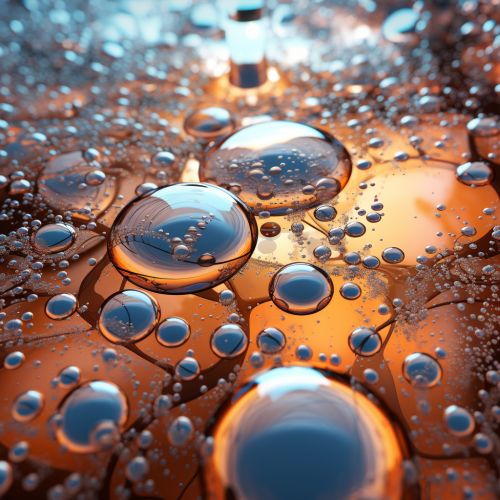Interfacial Phenomena in Colloidal Systems
Introduction
Interfacial phenomena in colloidal systems are a significant area of study in the field of physical chemistry. Colloids are mixtures wherein one substance is dispersed evenly throughout another. The substances making up these systems can be solid, liquid, or gas. The dispersed particles in the system are typically in the range of 1-1000 nanometers in diameter, which is small enough to be affected by Brownian motion but large enough to be affected by gravity and surface tension. The interface between the dispersed particles and the dispersing medium is of particular interest, as it is where many important physical and chemical processes occur.


Interfacial Phenomena
Interfacial phenomena refer to the physical and chemical behaviors that occur at the boundary between two phases in a colloidal system. These phenomena are influenced by the properties of the substances involved, the size and shape of the dispersed particles, and the conditions under which the system exists. They include adsorption, wetting, capillarity, and emulsification, among others.
Adsorption
Adsorption is the process by which atoms, ions, or molecules from a substance (it could be gas, liquid, or dissolved solid) adhere to a surface of the adsorbent. In a colloidal system, this can occur at the interface between the dispersed particles and the dispersing medium. Adsorption is a surface phenomenon, as the particles are attracted to the surface and not distributed throughout the volume of the substance.
Wetting
Wetting is the ability of a liquid to maintain contact with a solid surface, resulting from intermolecular interactions when the two are brought together. The degree of wetting (wettability) is determined by a force balance between adhesive and cohesive forces. In colloidal systems, wetting can influence the stability of the system and the behavior of the dispersed particles.
Capillarity
Capillarity (or capillary action) is the ability of a liquid to flow in narrow spaces without the assistance of, or even in opposition to, external forces like gravity. This effect can be seen in the drawing up of liquids between the hairs of a paint-brush, in a thin tube, in porous materials such as paper and plaster, and in some non-porous materials such as sand and liquefied carbon fiber. In colloidal systems, capillarity can cause the dispersed particles to move and cluster together, affecting the overall behavior of the system.
Emulsification
Emulsification is the process of mixing two immiscible liquids together, often with the help of an emulsifying agent. In a colloidal system, this can occur when the dispersed phase and the dispersing medium are immiscible liquids. Emulsification can help to stabilize the system and prevent the dispersed particles from separating out.
Interfacial Tension and Surfactants
Interfacial tension is a measure of the energy required to increase the surface area of a liquid by a unit amount. It is a result of the cohesive forces between the molecules in the liquid. In a colloidal system, interfacial tension can influence the shape and behavior of the dispersed particles.
Surfactants are substances that can reduce the interfacial tension in a colloidal system. They do this by adsorbing at the interface between the dispersed phase and the dispersing medium, effectively 'smoothing out' the interface and reducing the energy required to increase its area. Surfactants can be used to stabilize colloidal systems and control the behavior of the dispersed particles.
Applications of Interfacial Phenomena in Colloidal Systems
Understanding the interfacial phenomena in colloidal systems has many practical applications. These include the formulation of paints and inks, the production of food and beverages, the design of pharmaceuticals and cosmetics, and the treatment of industrial waste, among others.
In the food industry, for example, emulsification is used to mix oil and water in products like mayonnaise and salad dressings. In the pharmaceutical industry, surfactants are used to improve the solubility of drugs and enhance their absorption in the body.
In the environmental field, understanding adsorption can help in the design of water treatment processes, where contaminants are removed from water by adsorbing them onto a solid surface.
